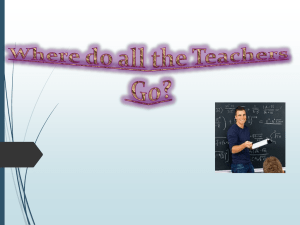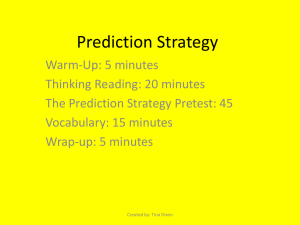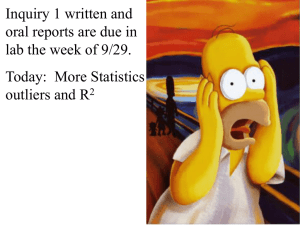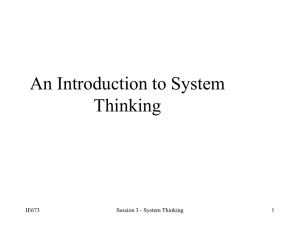Amplitudes and Ultraviolet Behavior of N=8 Supergravity
advertisement
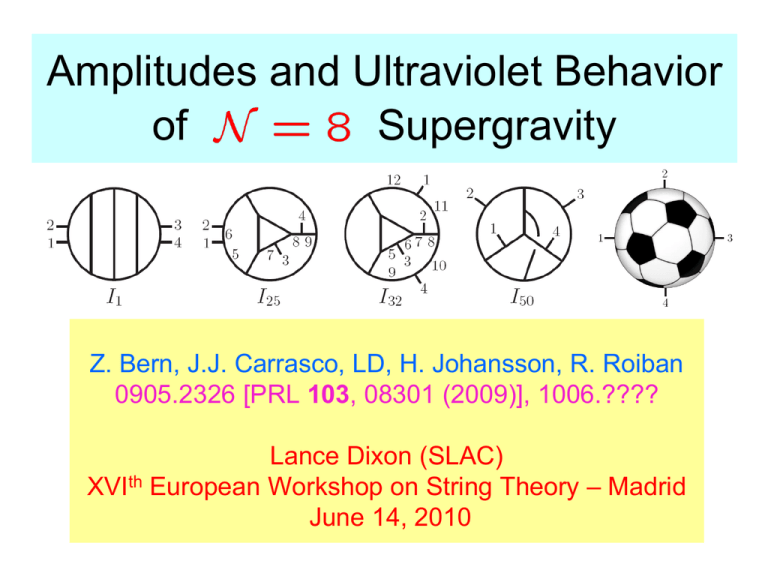
Amplitudes and Ultraviolet Behavior of Supergravity Z. Bern, J.J. Carrasco, LD, H. Johansson, R. Roiban 0905.2326 [PRL 103, 08301 (2009)], 1006.???? Lance Dixon (SLAC) XVIth European Workshop on String Theory – Madrid June 14, 2010 Introduction • Quantum gravity is nonrenormalizable by power counting: the coupling, Newton’s constant, GN = 1/MPl2 is dimensionful • String theory cures the divergences of quantum gravity by introducing a new length scale, the string tension, at which particles are no longer pointlike. • Is this necessary? Or could enough symmetry, e.g. N=8 supersymmetry, allow a point particle theory of quantum gravity to be perturbatively ultraviolet finite? • N=8 supergravity (ungauged) DeWit, Freedman (1977); Cremmer, Julia, Scherk (1978); Cremmer, Julia (1978,1979) • Other point-like proposals include flow to (conjectured?) nontrivial fixed points: - asymptotic safety program Weinberg (1977); ...; Niedermaier, Reuter, Liv. Rev. Rel. 9, 5 (2006) - UV theory could be Lorentz asymmetric, but renormalizable Hořava, 0812.4287, 0901.3775 • Here we will perturb around a (conjectured?) Gaussian fixed point Amplitudes & UV Behavior of N=8 L. Dixon Eurostrings 6/14/2010 2 Amplitudes & UV Behavior of N=8 L. Dixon Eurostrings 6/14/2010 3 Counterterm Basics - Divergences associated with local counterterms - On-shell counterterms are generally covariant, built out of products of Riemann tensor (& derivatives • Terms containing Ricci tensor and scalar removable by nonlinear field redefinition in Einstein action ) has mass dimension 2 GN = 1/MPl2 Each additional has mass dimension -2 or 1 more loop One-loop However, is Gauss-Bonnet term, total derivative in four dimensions. So pure gravity is UV finite at one loop (but not with matter) ‘t Hooft, Veltman (1974) Amplitudes & UV Behavior of N=8 L. Dixon Eurostrings 6/14/2010 4 Pure supergravity ( ): Divergences deferred to at least three loops cannot be supersymmetrized produces helicity amplitude (-+++) incompatible with Grisaru (1977); Deser, Kay, Stelle (1977); SUSY Ward identitites Tomboulis (1977) However, at three loops, there is an N=8 supersymmetric counterterm, abbreviated , plus (many) other terms containing other fields in N=8 multiplet. Deser, Kay, Stelle (1977); Howe, Lindstrom (1981); Kallosh (1981); Howe, Stelle, Townsend (1981) produces first subleading term in low-energy limit of 4-graviton scattering in type II string theory: Gross, Witten (1986) 4-graviton amplitude in (super)gravity Bose symmetric polynomial Amplitudes & UV Behavior of N=8 L. Dixon Eurostrings 6/14/2010 5 Constraints on Counterterms Elvang, Freedman, Kiermaier (2010) • Use locality of on-shell amplitudes + powerful N=8 SUSY Also related work by Kallosh Ward identitites • N=8 SWI for maximally helicity violating (MHV) amplitudes: • N=8 SWI for non-MHV amplitude – solved recently Elvang, Freedman, Kiermaier, 0911.3169 4-point MHV amounts to classifying Bose-symmetric polynomials still MHV can still use Bose-symmetry next-to-MHV analysis required Amplitudes & UV Behavior of N=8 L. Dixon Eurostrings 6/14/2010 6 Elvang, Freedman, Kiermaier (2010) Drummond, Heslop, Howe, Kerstan, th/0305202; Kallosh, 0906.3495 Until 7 loops, any divergences show up in 4-point amplitude! Amplitudes & UV Behavior of N=8 L. Dixon Eurostrings 6/14/2010 7 Constraints on Counterterms • N=8 SUGRA has a continuous symmetry group, a Cremmer, Julia (1978,1979) noncompact form of E7. • 70 scalars parametrize coset space E7(7)/SU(8), non-SU(8) part realized nonlinearly. • also implies amplitude Ward identities, associated with limits as one or two scalars become soft Bianchi, Elvang, Freedman, 0805.0757; Arkani-Hamed, Cachazo, Kaplan, 0808.1446; Kallosh, Kugo, 0811.3414 • Single-soft limit of NMHV 6-point matrix element of doesn’t vanish; indicates that violates Broedel, LD, 0911.5704 • non-invariance also suspected from superspace constructions Amplitudes & UV Behavior of N=8 L. Dixon Eurostrings 6/14/2010 8 Constraints (Cont.) • A 7-loop N=8 supersymmetric counterterm was constructed long ago, but it was noted that the construction was not invariant Howe, Lindstrom (1981) • More recent discussion of whether there is a (non-vanishing) 7-loop invariant counterterm from the volume of the on-shell N=8 superspace Brossard, Howe, Stelle 0908.3883 • 8-loop invariant counterterm definitely nonvanishing, coincides with Howe, Lindstrom (1981) ; Kallosh (1981) Amplitudes & UV Behavior of N=8 L. Dixon Eurostrings 6/14/2010 9 Other early hints that is very special • Found at two loops, and suggested for that does not appear without four extra derivatives divergence at five loops? … Bern, LD, Dunbar, Perelstein, Rozowsky (1998) • Superspace-based speculation that D=4 case diverges only at L=6, not L=5 Howe, Stelle, hep-th/0211279 • However, more recent analysis predicts D=4 case diverges at L=5, [and D=5 case diverges at L=4] unless additional cancellation Bossard, Howe, Stelle, 0901.4661 mechanisms are present • Multi-loop string results seem not to allow even past L=2 Berkovits, hep-th/0609006; Green, Russo, Vanhove, hep-th/0611273 • String/M duality arguments with similar conclusions, suggesting Green, Russo, Vanhove, hep-th/0610299 possible finiteness for all L. • Light-cone superspace suggests finiteness until L=7 Kallosh, 0903.4630 • “No triangle” cancellations for 1-loop amplitudes Amplitudes & UV Behavior of N=8 L. Dixon Eurostrings 6/14/2010 10 Zero-mode counting in string theory Berkovits, hep-th/0609006; Green, Russo, Vanhove, hep-th/0611273, 1002.3805; Björnsson, Green, 1004.2692 • Pure spinor formalism for type II superstring theory – spacetime supersymmetry manifest • Zero mode analysis of multi-loop 4-graviton amplitude in string theory implies: At L loops, for L < 7, effective action is For L = 7 and higher, run out of zero modes, and arguments gives • Very recently, same authors say that “technical issues in the pure spinor formalism” might make L = 5 • If results survives both the low-energy limit, a’ 0, and compactification to D=4 – i.e., no cancellations between massless modes and either stringy or Kaluza-Klein excitations – then it suggests first divergence at 9 loops 7 loops Amplitudes & UV Behavior of N=8 L. Dixon Eurostrings 6/14/2010 11 “No triangle” property Bjerrum-Bohr et al., hep-th/0610043; Bern, Carrasco, Forde, Ita, Johansson, 0707.1035 (pure gravity) ; Kallosh, 0711.2108; Bjerrum-Bohr, Vanhove, 0802.0868 Proofs: Bjerrum-Bohr, Vanhove, 0805.3682; Arkani-Hamed, Cachazo, Kaplan, 0808.1446 • Statement about UV behavior of N=8 SUGRA amplitudes at one loop but with arbitrarily many external legs: “N=8 UV behavior no worse than N=4 SYM at one loop” • Samples arbitrarily many powers of loop momenta • Necessary but not sufficient for excellent multi-loop behavior • Implies specific multi-loop cancellations Bern, LD, Roiban, th/0611086 gravity (spin 2) gauge theory (spin 1) Amplitudes & UV Behavior of N=8 L. Dixon Eurostrings 6/14/2010 12 UV info from scattering amplitudes: vs. • Study 4-graviton amplitudes in higher-dimensional versions of N=8 supergravity to see what critical dimension Dc they begin to diverge in, as a function of loop number L • Compare with analogous results for N=4 super-Yang-Mills theory (a finite theory in D = 4). Bern, LD, Dunbar, Perelstein, Rozowsky (1998) Key technical ideas: • Kawai-Lewellen-Tye (KLT) (1986) relations to express N=8 supergravity tree amplitudes in terms of simpler N=4 super-Yang-Mills tree amplitudes • Unitarity to reduce multi-loop amplitudes to products of trees Bern, LD, Dunbar, Kosower (1994) Results now available through four loops Amplitudes & UV Behavior of N=8 L. Dixon Eurostrings BCDJR, 0905.2326 6/14/2010 13 vs. DeWit, Freedman (1977); Cremmer, Julia, Scherk (1978); Cremmer, Julia (1978,1979) 28 = 256 massless states, ~ expansion of (x+y)8 SUSY 24 = 16 states ~ expansion of (x+y)4 Amplitudes & UV Behavior of N=8 L. Dixon Eurostrings 6/14/2010 14 Kawai-Lewellen-Tye relations KLT, 1986 Derive from relation between open & closed string amplitudes. Low-energy limit gives N=8 supergravity amplitudes as quadratic combinations of N=4 SYM amplitudes consistent with product structure of Fock space, Amplitudes & UV Behavior of N=8 L. Dixon Eurostrings 6/14/2010 , 15 Amplitudes via perturbative unitarity • S-matrix a unitary operator between in and out states unitarity relations (cutting rules) for amplitudes • Reconstruction of full amplitudes from cuts very efficient, due to simple structure of tree and lower-loop helicity amplitudes • Generalized unitarity (more propagators open) necessary to reduce everything to trees (in order to apply KLT relations) Amplitudes & UV Behavior of N=8 L. Dixon Eurostrings 6/14/2010 16 Multi-loop generalized unitarity Bern, LD, Kosower, hep-ph/0001001; Bern, Czakon, LD, Kosower, Smirnov hep-th/0610248; Bern, Carrasco, LD, Johansson, Kosower, Roiban, hep-th/0702112; BCJK, 0705.1864; Cachazo, Skinner, 0801.4574; Cachazo, 0803.1988; Cachazo, Spradlin, Volovich, 0805.4832 Ordinary cuts of multi-loop amplitudes contain loop amplitudes. For example, at 3 loops, one encounters the product of a 5-point tree and a 5-point one-loop amplitude: Cut 5-point loop amplitude further, into (4-point tree) x (5-point tree), in all 3 inequivalent ways: cut conditions satisfied by real momenta Amplitudes & UV Behavior of N=8 L. Dixon Eurostrings 6/14/2010 17 Method of maximal cuts Complex cut momenta make sense out of all-massless 3-point kinematics – can chop an amplitude entirely into 3-point trees maximal cuts Maximal cuts are maximally simple, yet give excellent starting point for constructing full answer For example, in planar (leading in Nc) N=4 SYM they find all terms in the complete answer for 1, 2 and 3 loops Remaining terms found systematically: Let 1 or 2 propagators collapse from each maximal cut near-maximal cuts Amplitudes & UV Behavior of N=8 L. Dixon Eurostrings 6/14/2010 18 Amplitude assembly from near-maximal cuts is child’s play Amplitudes & UV Behavior of N=8 L. Dixon Eurostrings 6/14/2010 19 Multi-loop “KLT copying” Bern, LD, Dunbar, Perelstein, Rozowsky (1998) • N=8 SUGRA cuts are products of N=8 SUGRA trees, summed over all internal states. • KLT relations let us write N=8 cuts very simply as: sums of products of two copies of N=4 SYM cuts • Need both planar (large Nc) and non-planar terms in corresponding multi-loop N=4 SYM amplitude Amplitudes & UV Behavior of N=8 L. Dixon Eurostrings 6/14/2010 20 KLT copying at 3 loops Using it is easy to see that N=8 SUGRA N=4 SYM N=4 SYM rational function of Lorentz products of external and cut momenta; all state sums already performed Amplitudes & UV Behavior of N=8 L. Dixon Eurostrings 6/14/2010 21 For L>2, UV behavior of generic integrals looks worse in N=8 N=4 SYM N=8 supergravity 2 from HE behavior of gravity Integral in D dimensions scales as Critical dimension Dc for log divergence (if no cancellations) obeys N=8 N=4 SYM BDDPR (1998) Amplitudes & UV Behavior of N=8 L. Dixon Eurostrings 6/14/2010 22 But: No-triangle better behavior 2-particle cut exposes Regge-like ladder topology, containing numerator factor of L-particle cut exposes one-loop (L+2)-point amplitude – but would (heavily) violate the no-triangle property • Implies additional cancellations in the left loop BDR hep-th/0611086 • Inspired computation of full 4-graviton amplitude at 3 & 4 loops Amplitudes & UV Behavior of N=8 L. Dixon Eurostrings 6/14/2010 23 3 loop amplitude Bern, Carrasco, LD, Johansson, Kosower, Roiban, th/0702112 Bern, Carrasco, LD, Johansson, Roiban, 0808.4112 Nine basic integral topologies Seven (a)-(g) long known (2-particle cuts easily determine using “rung rule”) BDDPR (1998) Two new ones (h), (i) have no 2-particle cuts Amplitudes & UV Behavior of N=8 L. Dixon Eurostrings 6/14/2010 24 N=4 numerators at 3 loops Overall manifestly quadratic in loop momentum Amplitudes & UV Behavior of N=8 L. Dixon Eurostrings 6/14/2010 25 N=8 numerators at 3 loops Overall also manifestly quadratic in loop momentum Amplitudes & UV Behavior of N=8 L. Dixon Eurostrings BCDJR (2008) 6/14/2010 26 N=8 no worse than N=4 SYM in UV Manifest quadratic representation at 3 loops – same behavior as N=4 SYM – implies same critical dimension still for L = 3: • Evaluate UV poles in integrals no further cancellation • At 3 loops, Dc = 6 for N=8 SUGRA as well as N=4 SYM: counterterm Recently recovered via string theory (up to factor of 9?) Green, Russo, Vanhove,1002.3805 Amplitudes & UV Behavior of N=8 L. Dixon Eurostrings 6/14/2010 27 4 loops • Begin with 4-loop cubic vacuum graphs • Decorate them with 4 external legs to generate 50 nonvanishing cubic 4-point graphs • Determine the 50 numerator factors, first for N=4 SYM, then, using KLT, for N=8 supergravity cannot generate a nonvanishing (no-triangle) cubic 4-point graph only generate rung rule topologies Amplitudes & UV Behavior of N=8 L. Dixon the most complex Eurostrings 6/14/2010 28 4 loop graphs Number of cubic 4-point graphs with nonvanishing coefficients and various topological properties: simple method to get numerator fails worked out for N=4 in 2006 (BCDKS) Amplitudes & UV Behavior of N=8 L. Dixon Eurostrings 6/14/2010 another method fails 29 Box cut Bern, Carrasco, Johansson, Kosower, 0705.1864 • If the diagram contains a box subdiagram, can use the simplicity of the 1-loop 4-point amplitude to compute the numerator very simply • Planar example: • Only five 4-loop cubic topologies do not have box subdiagrams. • But there are also “contact terms” to determine. Amplitudes & UV Behavior of N=8 L. Dixon Eurostrings 6/14/2010 30 Twist identity • If the diagram contains a four-point tree subdiagram, can use a Jacobi-like identity to relate it to other diagrams. Bern, Carrasco, Johansson, 0805.3993 • Relate non-planar topologies to planar, etc. • For example, at 3 loops, (i) = (e) – (e)T [ + contact terms ] 3 1 4 - = Amplitudes & UV Behavior of N=8 2 L. Dixon Eurostrings 6/14/2010 31 Simplest (rung rule) graphs N=4 SYM numerators shown Amplitudes & UV Behavior of N=8 L. Dixon Eurostrings 6/14/2010 32 N=4 SYM numerators for most complex graphs [N=8 SUGRA numerators much larger] Amplitudes & UV Behavior of N=8 L. Dixon Eurostrings 6/14/2010 33 Checks on N=4 result • Lots of different products of MHV tree amplitudes. • NMHV7 * anti-NMHV7 and MHV5 * NMHV6 * anti-MHV5 – evaluated by Elvang, Freedman, Kiermaier, 0808.1720 Amplitudes & UV Behavior of N=8 L. Dixon Eurostrings 6/14/2010 34 UV behavior of N=8 at 4 loops • All 50 cubic graphs have numerator factors composed of terms loop momenta l external momenta k • Maximum value of m turns out to be 8 in every integral • Integrals all have 13 propagators, so • Manifestly finite in D=4: 4 x 4 + 8 – 26 = - 2 < 0 • Not manifestly finite in D=5: 4 x 5 + 8 – 26 = + 2 > 0 In order to show that Amplitudes & UV Behavior of N=8 all cancel need to show that L. Dixon Eurostrings 6/14/2010 35 Cancellations between integrals • Cancellation of k4 l8 terms [vanishing of coefficient of simple: just set external momenta ki 0, collect coefficients of 2 resulting vacuum diagrams, observe that the 2 coefficients cancel. ] of k5 l7 [and k7 l5] terms is trivial: Lorentz invariance does not allow an odd-power divergence. • Cancellation of k6 l6 terms [vanishing of coefficient of ] more intricate: Expand to second subleading order in limit ki 0, generating 30 different vacuum integrals. • Evaluating UV poles for all 30 integrals (or alternatively deriving consistency relations between them), we find that • Cancellation UV pole cancels in D=5-2e N=8 SUGRA still no worse than N=4 SYM in UV at 4 loops! Amplitudes & UV Behavior of N=8 L. Dixon Eurostrings 6/14/2010 36 Peeking beyond four loops higher-loop cancellations inferred from 1-loop n-point (no triangle hypothesis) inferred from 2-, 3-, 4-loop 4-point, via cuts Same UV behavior as N=4 super-Yang-Mills # of loops UV behavior unknown … # of contributions explicit 1, 2, 3 and 4 loop computations Amplitudes & UV Behavior of N=8 L. Dixon Eurostrings 6/14/2010 37 5 loops? A bit daunting, but more enticing now that GRV 1002.3805, Vanhove 1004.1392, BG 1004.2692 speculate that L=5 behavior might be worse than N=8 worse than N=4 at only L=5 Number of cubic 4-point graphs with nonvanishing coefficients worked out for N=4 in 2007 (BCJK) Amplitudes & UV Behavior of N=8 L. Dixon Eurostrings 6/14/2010 38 What might it all mean? • Suppose N=8 SUGRA is finite to all loop orders. • Does this mean it is a nonperturbatively consistent theory of quantum gravity? • No! • At least two reasons it might need a nonperturbative completion: • Likely L! or worse growth of the order L coefficients, ~ L! (s/MPl2)L • Different E7(7) behavior of the perturbative series (invariant!) compared with the E7(7) behavior of the mass spectrum of black holes (non-invariant!) Amplitudes & UV Behavior of N=8 L. Dixon Eurostrings 6/14/2010 39 Is N=8 SUGRA “only” as good as QED? • QED is renormalizable, but its perturbation series has zero radius of convergence in a: ~ L! aL • UV renormalons associated with UV Landau pole • But for small a it works pretty well: ge - 2 agrees with experiment to 10 digits • Also, tree-level (super)gravity works well for s << MPl2 • Many pointlike nonperturbative UV completions for QED: asymptotically free GUTs • What is/are nonperturbative UV completion(s) for N=8 SUGRA? Could some be pointlike too? • Some say N=8 SUGRA is in the “Swampland” – not connected to string theory beyond p.t. Green, Ooguri, Schwarz • If so, then maybe UV completion has to be pointlike?! Amplitudes & UV Behavior of N=8 L. Dixon Eurostrings 6/14/2010 40 Conclusions and open questions • Through 4 loops, 4-graviton scattering amplitude of N=8 supergravity has UV behavior no worse than the corresponding 4-gluon amplitude of N=4 SYM. • Will same continue to happen at higher loops? Partial evidence from generalized unitarity supports this, but 5 loops is the (next) acid test. • If so, N=8 supergravity would be a perturbatively finite, pointlike theory of quantum gravity. • Is there a nonperturbative UV completion? • Although it may not be of direct phenomenological relevance, could N=8 cancellations point the way to other, more realistic, finite theories with less supersymmetry? Amplitudes & UV Behavior of N=8 L. Dixon Eurostrings 6/14/2010 41 Extra slides Amplitudes & UV Behavior of N=8 L. Dixon Eurostrings 6/14/2010 42 All the N=8 SUGRA details you could ever want … and more In two locations we provide all 50 numerator factors for the 4-loop N=8 SUGRA amplitude, in Mathematica readable files: • aux/* in the source of the arXiv version of 0905.2326 [hep-th] • EPAPS Document No. E-PRLTAO-103-025932 (Windows-compatible) Plus: • use Mathematica’s free Player to rotate 3D views of all 50 graphs • Mathematica tools for extracting information about the 50 numerators, etc. Amplitudes & UV Behavior of N=8 L. Dixon Eurostrings 6/14/2010 43 N=4 SYM in UV at three loops • UV poles of integrals in Dc = 6 - 2e [BCDJR 2008] dressed with color factors • Corresponds to type counterterms. • Absence of double-trace terms of form at L = 3. Amplitudes & UV Behavior of N=8 L. Dixon Eurostrings 6/14/2010 44 N=4 SYM in UV at four loops • Combining UV poles of integrals in Dc = 5.5 - 2e with color factors • Vi are 4-loop vacuum integrals • Again corresponds to type counterterms. • Later arguments for absence of double-trace terms at L = 3,4 – string theory Berkovits, Green, Russo, Vanhove, 0908.1923 – ¼ BPS invariant protected Bossard, Howe, Stelle 0908.3883 Amplitudes & UV Behavior of N=8 L. Dixon Eurostrings 6/14/2010 45

